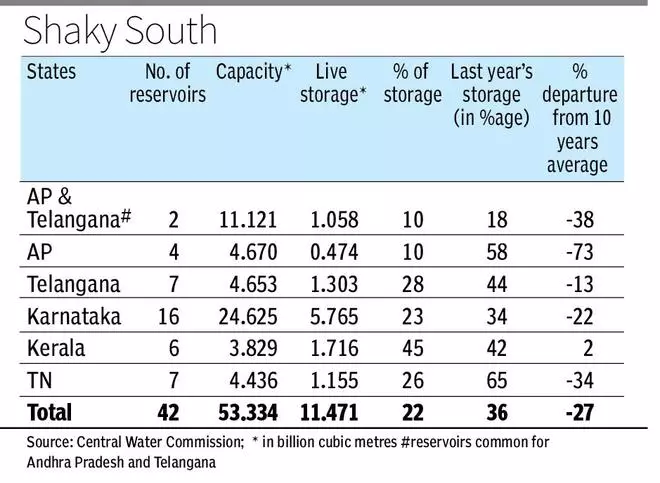

India reservoir storage woes continue to mount, particularly in the South where five have gone dry and the level in another 10 is in single digits.
For the 25th week in a row, the water level in the 150 major reservoirs declined. Data from the Central Water Commission (CWC) showed that the storage in the major reservoirs declined to 36 per cent of the 178.784 billion cubic metres (BCM) capacity at 64.606 BCM.

According to CWC’s weekly bulletin on live storage status of 150 reservoirs, almost three-fourths of the major reservoirs have below 50 per cent storage. While the level in 86 reservoirs is lower than 40 per cent of the capacity, in another 24 it is below 50 per cent.
Overall, half a dozen reservoirs have gone dry and the level in a dozen is in single digits. And most of the reservoirs (35) whose level is below 50 per cent of the capacity are in the southern region.
The situation is turning worrisome in the southern region with the storage in the 42 reservoirs dropping to 22 per cent of the 53.334 BCM capacity at 11.471 BCM. During the same time a year ago, the level was 36 per cent of the capacity and if the last 10 years average is taken into consideration, it is 27 per cent lower (See table).
Among the States, the level is 77 per cent below normal in Bihar’s lone reservoir, while in Andhra Pradesh’s four reservoirs it is 73 per cent lower than normal. In Tamil Nadu, the storage is 34 per cent below normal and in Karnataka it is 22 per cent lower. In Telangana, the storage is 12 per cent lower than normal.
As regards reservoirs, Yeluru (Andhra), Priyadarshini Jurala and Kaddam (both Telangana), Tattihalla (Karnataka) and Aliyar (Tamil Nadu) have gone dry. Sholayar (Tamil Nadu), Tungabhadra, Kandaleru and Nagarjuna Sagar are set to go dry anytime over the next few days, data from the bulletin showed.
A major reason for the current situation is the peninsular region receiving deficient rainfall since the El Nino emerged in June 2023 with Karnataka and Andhra Pradesh being the worst hit. The scary water situation has affected various agricultural and horticultural crops from paddy to pulses to coarse cereals to tomatoes.
The India Meteorological Department (IMD) has predicted above-normal maximum temperatures in the peninsular region over the next few days. Of the 711 districts from where IMD has received data, 46 per cent of the country received deficient or no rainfall.
In the northern region, the storage was 32 per cent of the 19.663 BCM capacity at 6.290 BCM. The situation is not as bad as in the southern region as the storage was 38 per cent a year ago and the average level in the past 10 years has been 33 per cent. In addition, the region can expect water from the snow in the Himalayas from April.
In the 23 reservoirs in the eastern region, the storage was 47.9 per cent of the 20.430 BCM capacity at 9.702 BCM. Apart from Bihar, the level in Bengal (-28%), Odisha (-1%) and Nagaland (-6%) is lower than normal.
In the central region, the level in the 26 major reservoirs was 44 per cent of 48.227 BCM capacity at 21.438 BCM. The level in Uttar Pradesh (-29%) and Chhattisgarh (-27%) was lower than normal.
The level in 49 reservoirs in the western region was 42 per cent of the 37.130 BCM at 15.705 BCM. In Maharashtra, the storage was 12 per cent below normal.
In all the regions barring the southern region, the storage is higher than the last 10 years average.
Published on March 28, 2024

Comments
Comments have to be in English, and in full sentences. They cannot be abusive or personal. Please abide by our community guidelines for posting your comments.
We have migrated to a new commenting platform. If you are already a registered user of TheHindu Businessline and logged in, you may continue to engage with our articles. If you do not have an account please register and login to post comments. Users can access their older comments by logging into their accounts on Vuukle.